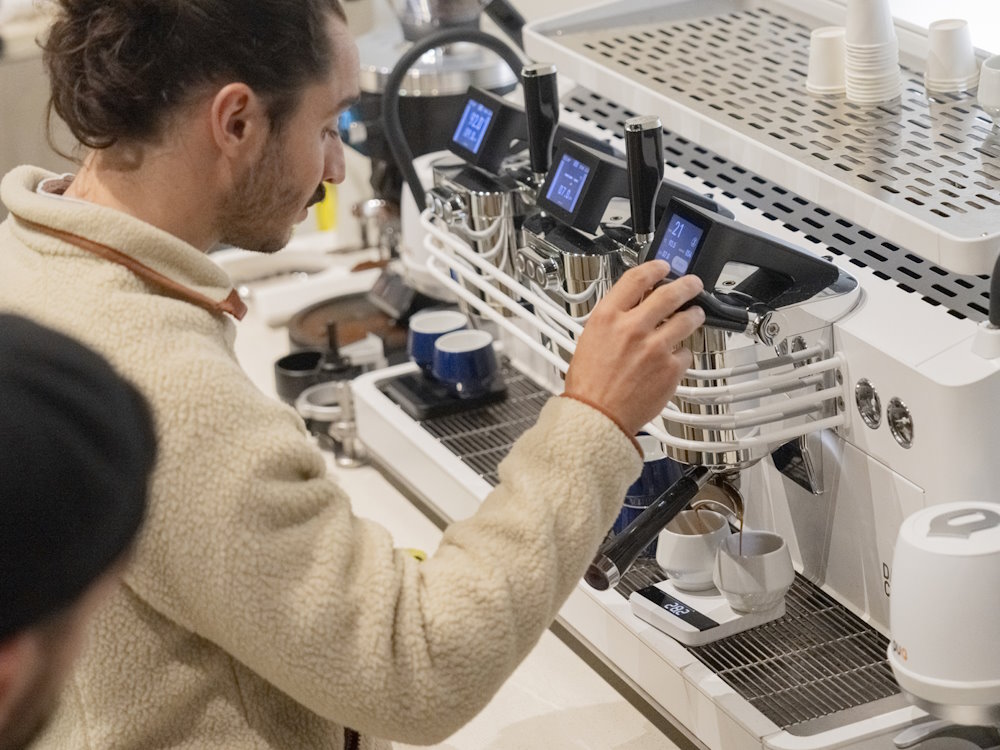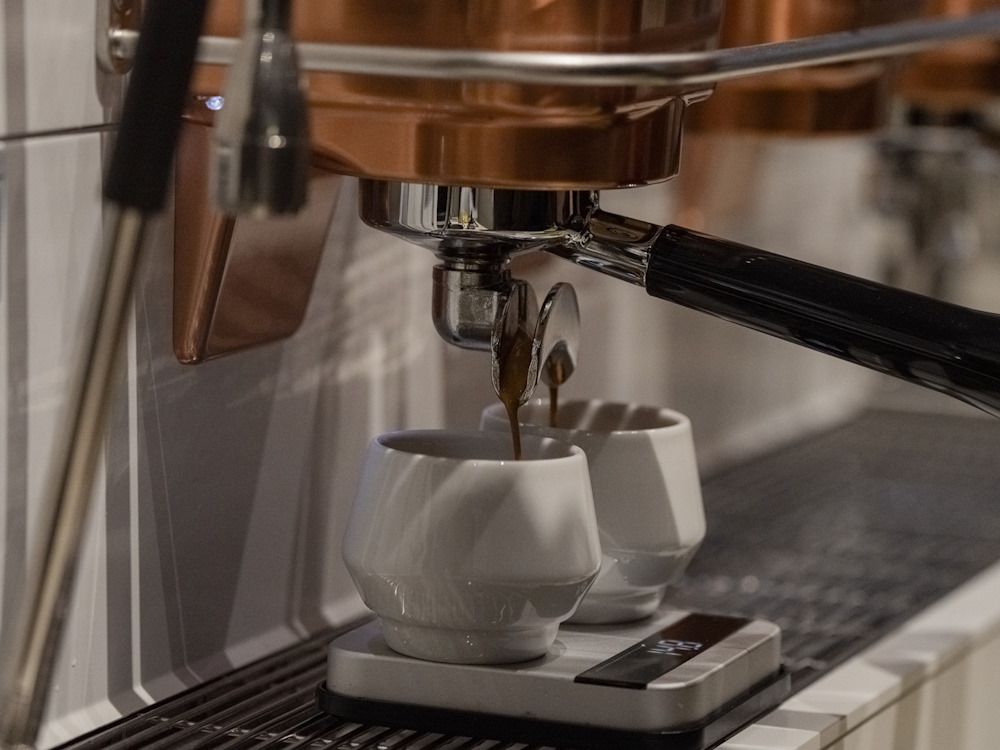Extracting the perfect espresso is both a science and an art. There are many factors at play, from pressure to grind size to temperature to time. Baristas dedicate hours to finetuning these variables to prepare consistently high-quality espresso for customers.
But as espresso machine technology has become much more advanced over the last decade, baristas now have a wider range of variables to experiment with. One of these is flow profiling, which involves controlling how much water passes through a grouphead while the machine’s pump is activated.
Changing the flow rate offers baristas a new level of control over espresso extraction, potentially unlocking nuanced and delicate flavours that heighten the consumer experience. As machine technology becomes even more advanced, intuitive, and accessible, more and more specialty coffee shops are likely to use flow profiling to their advantage.
To learn more, I spoke to Alessandro Zengiaro, Customer and Aftersales Service Trainer at professional coffee equipment manufacturer Dalla Corte. Read on for his insight into how flow profiling can help baristas control extraction.
You may also like our article on how espresso grinders are leading innovation in specialty coffee.
How flow profiling became a key variable for espresso extraction
Traditionally, dose, yield, extraction time, and grind size were the four main variables used to prepare espresso. While all are still equally important today, as espresso machine technology has advanced over the last ten years, baristas have to consider an even wider range of factors.
“Baristas want to control extraction as much as possible so they can achieve the best results consistently, cup after cup,” says Alessandro, multi-time UK Latte Art Champion and Customer and Aftersales Service Trainer at Dalla Corte.
Temperature and pressure have become increasingly prominent variables in espresso in recent years. By setting precise group head temperatures and changing pressure throughout the extraction process, baristas can open up entirely new flavour experiences.
Flow profiling is another variable that more and more coffee shops have started to use. Essentially, it involves controlling the amount of water that passes through the grouphead per second. Most commercial machines have a flow rate of between 250g and 500g per 30 seconds (g/30s), but to achieve more consistent results, the ideal range is considered to be between 200g and 280g/30s.
It’s also important to note that pressure and flow rate are inherently connected. As the pressure gradually rises, the flow rate will also increase proportionally. To ensure the flow rate doesn’t fluctuate too much, pressure needs to be tightly controlled throughout extraction.
Historically, baristas would manually adjust pressure to control the flow rate indirectly. But as machine technology has significantly improved in the last few years, flow profiling has become more manageable and less complicated.
In turn, baristas are able to precisely target their desired levels of acidity, sweetness, bitterness, and body to get the most out of a coffee and ultimately enhance the customer experience.
Why pre-infusion is important
Flow profiling is possible at any stage of espresso extraction, but it’s particularly pertinent during pre-infusion. This is when water is introduced to ground coffee at lower pressures so that the puck is fully saturated before higher pressures are applied.
“It’s the most delicate part of the process, which is why we developed a dedicated flow profiling feature for its machines,” Alessandro says.
He tells me that Dalla Corte’s patented Digital Flow Regulation (DFR) technology includes a precision valve that allows users to set the amount of water coming into the supply system and flowing to the grouphead. The opening of the valve can be controlled in up to five different steps, including during pre-infusion.
Pre-infusion is essential for preparing high-quality espresso. If the puck is not fully saturated before the pressure is increased, water won’t be able to move evenly through the ground coffee, resulting in uneven extraction and channelling.
Moreover, different coffees require varying amounts of pressure and different flow rates in the initial stages of extraction. For example, a lighter-roasted coffee generally needs a gentler pre-infusion to ensure more delicate volatile compounds are extracted.
“The purpose of our Digital Flow Regulation technology is to give baristas and coffee enthusiasts versatility,” Alessandro says. “Every day is different at a coffee shop, and the beans used will change over time. Baristas need to be able to adjust the performance of their equipment based on the day and the coffee they have.”

Why more espresso machine manufacturers are focusing on flow profiling
With baristas demanding more control over extraction variables than ever before, flow profiling has become one of the most in-demand features of modern espresso machines.
“Experimenting with flow profiling is an effective way to achieve a consistent cup profile, especially as coffee degasses and becomes less fresh,” Alessandro says. “Moreover, if a café is using coffees from different roasteries around the world, they can adjust the flow rate in their recipes to best suit the beans they’re serving that day.
“Roasters who need to taste samples can also tweak the flow rate for batches that were roasted only days ago, bypassing the degassing period and improving operational efficiency,” he adds.
As more equipment manufacturers integrate flow profiling features into their machines, it becomes easier for coffee professionals to leverage this technology.
During extraction, baristas have a seemingly endless number of variables to focus on to produce consistently excellent results. On top of preparing high-quality beverages, they also need to engage with customers, maintain stock levels, and carry out a number of other tasks, meaning automated features are a useful tool to help streamline café operations.
Alessandro explains that Dalla Corte’s Digital Flow Regulation – available on the Mina and Zero, and the Zero Plus in the coming months – can be controlled using an integrated app and touchscreen interface.
“Each grouphead includes a lever, which adjusts according to the set flow rate and pressure. “When the user changes the variables, it sends a signal to the mainboard, which controls the DFR feature. The lever moves to allow more or less water to pass through during a set time period.”

How to get the best results by controlling flow rate
Even for more experienced baristas, flow profiling may seem intimidating at first, but with practice and experimentation, the process can become more familiar. There are many initial steps that baristas can take to understand more about flow rate, including measuring it on their machine.
This is done by running water through each grouphead (without coffee and a portafilter) for a set period of time and using a scale to measure the volume. If there is 200g of water within 20 seconds, the machine’s flow rate is 10g per second, meaning baristas have a baseline from which to work.
“My suggestion is to not overcomplicate things, especially in the beginning,” Alessandro says. “Start by experimenting with typical parameters, but use a ‘flat’ profile where the flow rate remains consistent across the entire extraction.
“Then move to a two-step extraction where you use different flow rates, one for pre-infusion and another one for the rest of the extraction,” he adds. “When you feel comfortable with how the flow rate affects flavour, the possibilities are endless.”
Leveraging automation is key
Advanced flow profiling features help facilitate the process, making it easier for baristas and prosumers to understand when to increase or decrease flow rate and how this impacts coffee flavour.
But Alessandro points out that even when using automated technology, baristas need to apply their skills and expertise to control flow rate effectively and precisely.
“It’s not just the machine that impacts flow profiling, but the coffee as well,” he says. “Dalla Corte’s Digital Flow Regulation gives baristas full control over extraction, but they also need to use their coffee knowledge to achieve the best results.
“If your espresso tastes good, don’t stop experimenting,” he adds. “There is always more opportunity to make it even better, especially with flow profiling.”

Flow profiling has become a more prominent feature of modern espresso machines, and as baristas push to experiment even further with espresso extraction and flavour, more specialty coffee shops are likely to use this technology.
As coffee consumers demand new flavour experiences, flow profiling presents an opportunity to unlock different and more nuanced tasting notes, tapping into the full potential of coffee.
Enjoyed this? Then read our article on why investing in barista training is key to a successful coffee industry.
Photo credits: Dalla Corte
Perfect Daily Grind
Please note: Dalla Corte is a sponsor of Perfect Daily Grind.
Want to read more articles like this? Sign up for our newsletter!
The post How flow profiling can help baristas control extraction appeared first on Perfect Daily Grind.

